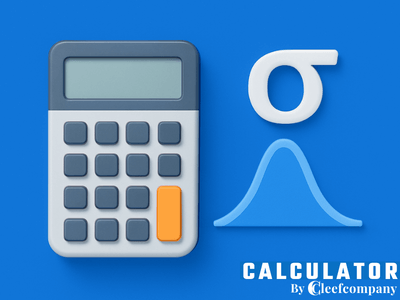Standard Deviation Calculator – Measure variability accurately
With this tool, you can find out how dispersed your data is relative to the mean, whether in a population or sample study.
✅ Fast and accurate – Just enter your details and get the result instantly.
✅ Avoid errors – Automatic calculation without the need for Excel sheets.
✅ Optimize your analysis – Detect variability with a single click.
Use our calculator now and get results in seconds.
Example Calculation with the Standard Deviation Calculator
Imagine you are analyzing the results of an exam:
Values: 70, 75, 80, 85, 90
📐 Formula applied (sample): √[Σ(xi – x̄)² / (n – 1)]
📊 Result: 7.9
This means that the scores are spread out around 7.9 points from the average.
📢 Optimize your decisions with real, measurable data.
How Our Standard Deviation Calculator Works
Our calculator follows a simple three-step process:
1️⃣ Data Entry
Enter the list of numeric values separated by commas 📉 (for example: 50, 52, 48, 60).
Select whether you want to calculate the population or sample standard deviation.
Why is it important?
Because understanding variability allows you to understand whether your data is consistent or dispersed, which is crucial for statistical, academic, and business decisions.
2️⃣ Automatic Calculation
We use the classic formulas for each case:
📐 Population: √[Σ(xi – μ)² / N]
📐 Sample: √[Σ(xi – x̄)² / (n – 1)]
3️⃣ Results and Recommendations
🔹 If the value is low, your data is consistent and stable.
🔹 If the value is high, there is a lot of variability in your data.
📢 Want to improve your analysis and decision-making? Try our tools for 30 days free.
This is only for entrepreneurs, business owners, and freelancers who want to improve their data analysis, optimize decisions, and save valuable time.
🚀 If you need to launch your website, SaaS or online store, visit NippyLaunch.com
📈 If you need to do digital advertising and marketing for your company, visit CleefCompany.com
What is the Standard Deviation Calculator?
The Standard Deviation Calculator allows you to determine how far data differ from the mean. It's ideal for measuring consistency and dispersion in statistical, financial, educational, and other studies.
👉 Make accurate decisions by identifying the true variability of your data.
Recommended Books to Master Standard Deviation
Improve your statistical skills with these key readings
These books will help you better understand standard deviation, its practical application, and how to use it to make more informed decisions.
1️⃣ Statistics for Business – Paul Newbold
Learn solid foundations for applying statistics to business decisions.
2️⃣ How to Lie with Statistics – Darrell Huff
Understand how data is manipulated and how to critically interpret results.
3️⃣ The Art of Thinking Clearly – Rolf Dobelli
Improve your logical thinking with examples applicable to statistical analysis.
Why Use Our Standard Deviation Calculator?
✅ Speed – Immediate results without manual calculations.
✅ Precision – Exact formulas with proven statistical logic.
✅ Ease – You don’t need technical knowledge.
✅ Application – Ideal for data analysis, surveys, education, and more.
Avoid These Common Mistakes When Using the Calculator
🚫 Entering incorrectly separated data (use commas, not spaces).
🚫 Confusing population calculation with sample calculation.
🚫 Not verifying that the entered values are all numeric.
Use our tool and avoid errors that can distort your analysis.
Comparison: Calculator vs. Manual Calculation
Why use our calculator instead of doing the calculations by hand?
✅ Save time and reduce errors.
✅ Accessible from any device without the need for software.
✅ Guaranteed accuracy with validated statistical formulas.
Frequently Asked Questions about the Standard Deviation Calculator
How to calculate standard deviation easily?
Just enter your list of values, select whether you want a sample or population calculation, and get the result instantly.
What data do I need to calculate it?
You just need a series of numeric values separated by commas.
What does a high standard deviation mean?
It means that your data is very dispersed with respect to the mean.
What is the formula used?
📐 Population: √[Σ(xi – μ)² / N]
📐 Sample: √[Σ(xi – x̄)² / (n – 1)]
What application does it have in business or research?
It allows you to understand the variability in results, sales, surveys, among others.
Can I use it without knowledge of statistics?
Yes. The tool is intuitive and requires no prior experience.
Which is better: sample or population calculation?
It depends on whether you are analyzing a sample or the entire population of data.
Does it work with a lot of data?
Yes, you can enter from a few to hundreds of values without any problem.
How to interpret the result?
A low value indicates consistency; a high value indicates significant dispersion.
Is the tool free?
Yes, you can use it online at no cost or installation required.

